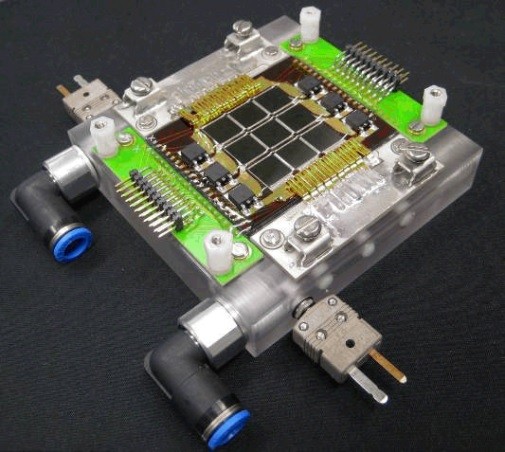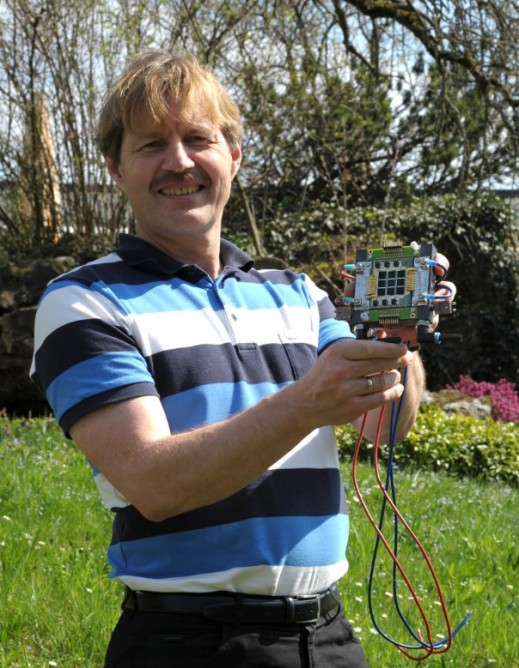
Written by: NiRA
“IBM has worked with Swiss company Airlight Energy to create an advanced solar electricity generator called the High Concentration PhotoVoltaic Thermal (HCPVT) system. The prototype was officially unveiled in Zurich in September 2014.”
IBM’s High Concentration Photovoltaic Thermal (HCPVT) system which is somewhat like a 10 metre tall sunflower, concentrates sun’s radiation to 2,000 times on a single spot and then converts 80% of that into energy which one can use. By using several liquid-cooled micro channel receivers, each furnished with an array of multi-junction photovoltaic chips, each chip produces up to 57 watts and each generator about 12 kilowatts of electricity, up to 20 kilowatts on a sunny day; enough energy to supply several households. 
The receiver with its triple-junction PV cells (Photo: IBM)
Airlight Energy which is a Swiss-based supplier of solar power technology has partnered with IBD Research to use IBM’s direct wam-water cooling design, water adsorption technologies, and influence IBM’s earlier works with multi-chip solar receivers improved in a teamwork between IBM and Egypt Nanotechnology Research Centre to modify and produce the system.
The HCPVT system prototype uses a 430.5-sq-ft parabolic dish coated with 36 plastic foil elliptic glasses which is only 0.2 mm thick, the HCPVT system prototype focuses sun’s radiation on few liquid-cooled receivers, each of these contains an array of 1x1cm2 chips that each produce up to 57 watts of electrical energy when functioning throughout a usual sunny day. Together, the complete system generates a whole of 12kW electrical energy and 20kW of warmth in the same time period. 
The prototype electronics and cooling system for the HCPVT (Photo: IBM)
Areas of interest for the device include southern Europe, Africa, and the Middle East, the South-western part of North America, South America, Japan and Australia. In addition, the system could be used at remote hospitals and medical facilities, and even for commercial purposes such as for hotels, holiday resorts and shopping centres.
Micro-organized courses pump treated water around these recipients to divert abundance heat at a rate that is guaranteed to be 10 times more compelling than aloof air cooling. Despite the fact that the water is still consequently warmed to around 85-90° C, the expulsion of high temperature from the chips keeps them at a generally cool safe working temperature of around 105° C. Without this cooling, the concentrated vitality of the sun would see the chips achieve temperatures of in excess of 1,500° C.
IBM scientist Dr. Bruno Michel holds the receiver design package (Photo: IBM)
Dr. Bruno Michel who is the manager of advanced thermal packaging at IBM Research stated:-
“The direct cooling technology with very small pumping power used to cool the photovoltaic chips with water is inspired by the hierarchical branched blood supply system of the human body”
HCPVT system can also be altered to use the cooling system to supply consumable water and air conditioning from the hot water output generated. Saline water is passed through the heating channels before being run through a penetrable membrane distillation system; here it is now evaporated and desalinated. To generate cool air for the household the surplus heat can be run through an adsorption chiller which is a condenser heat exchanger that uses water instead of other chemicals as the refrigerant medium.
Guesses on the functioning duration for the HCPVT system is about 60 years with adequate care which includes replacing the shielding foil and the elliptic mirrors in every 10 – 15 years depending on the ecological circumstances and the PV cells which will necessitate substitution in the end of their working life of about 25 years.
The inventors declare that this system adaptation could supply up to 40 litres of consumable water per square metre of receiver area each day, with a huge multi-dish installation theoretically capable to supply enough water to an entire minor town.
All of these factors, – surplus energy consumed for distillation and air-conditioning joint with 25 % produce on solar energy – accompanied by the setup’s sun tracking system that constantly places the dish at the best angle throughout the day, together to generate the stated 80 % energy proficiency.
There are more sunflower-type heliostats, for example those that transmit sunlight in a domestic state or on the other hand in industrial applications which generates numerous Megawatts of energy. The HCPVT system can be counted more like a super-efficient, multi-house power plant where the claimed effectiveness of the sunflower design proves its value as a medium-scale answer to off-grid supportable power requirements.
Earliest versions of the HCPVT system will soon be offered with non-optimized predecessor distillation and absorption cooling systems with optimized desalination and adsorption cooling wanting an additional 2 or 3 years to develop and release in the market.
As an action to release such technology in the market incapable to afford to buy their own system, Airlight & IBM also donated a HCPVT system to 2 communities through a competitive application. Each of these successful communities will be given a prototype HCPVT system from Airlight Energy and be appropriate for no-cost set up and adaptation assistance from IBM Corporate Service Corps.
Applications from communities will be open someday in 2015 and he winners will be declared in December 2015 and the installations will be beginning in 2016. A completely commercial HCPVT system is anticipated to be released in the market someday in 2017.
_______________________________________________________________
Source:- http://www.gizmag.com/ibm-sunflower-hcpvt-pv-thermal-solar-concentrator/33989/






Im thinking, $200k plus per unit. that would sound like IBM.
Thanks for your interest. Actually you are quite a bit off. We need to compete with existing solar concentration technologies and we are targeting places like Africa and India. We are hosting a competition to build two of the prototypes in the world for testing. Nominate your hometown at ibm.biz/sunhcpvt
I’m thinking Xeon, that this tech can be chaned altered and then reapplied cheaply or for free by you or anyone with a little bit of knowledge.
Though i can see the benefits for africa, if they decided to put these up there. Then that would bring in some amount of revenue, Still though they wont because the more death the more profit they make. Using Charities as a way of hding there dirty money
o homem e tao inteligente e capaz,mas tao destruidor..
I was thinking that, but i have so many projects running right now. Once i get my car finished or one of my laser projects done then ill prob start on this
DEAR SIR,
IT IS REQUEST FOR SOLAR POWER SUNFLOWER
BEING A SOCIAL WORKER REPRESENTATIVE IT IS REQUESTED TO YOU PLZ INSTALL THIS PROJECT AT MY VILLAGE, IT IS VERY POOR VILLAGE AND THE WATER IN OUR VILLAGE IS VERY DIRTY AND SALTY. AS WE USE THIS WATER IT DIRECTLY TO LEAD TO DIARIA, AND LOSE MOTION TO CHILDES. AND ELECTRICITY LOAD SHEDDING IN OUT TOWN IS VERY SEVER. SO I REQUEST YOU TO INSTALL THIS PACKAGE IN OUR TOWN. WE WILL PROVIDE YOUR FULL ASSISTANCE AND LAND FOR THIS INSTALLATION. AND ALSO TIMELY FEED BACK FOR YOUR SUNFLOWER PROJECT.
BEGGING REQUEST
SHAHID MEHMOOD
Seat # 40 Ahata Katchery Ahmadpur East
District Bahawalpur, Phone # 92-308-7618740.
Instead of water: Why not cool the unit by boiling methylene-chloride at the heat exchange point thus using the “waste heat” to drive a generator and converting those thousands of currently wasted joules of heat energy into power along with the photo-voltaic effect. Sheeeesh…